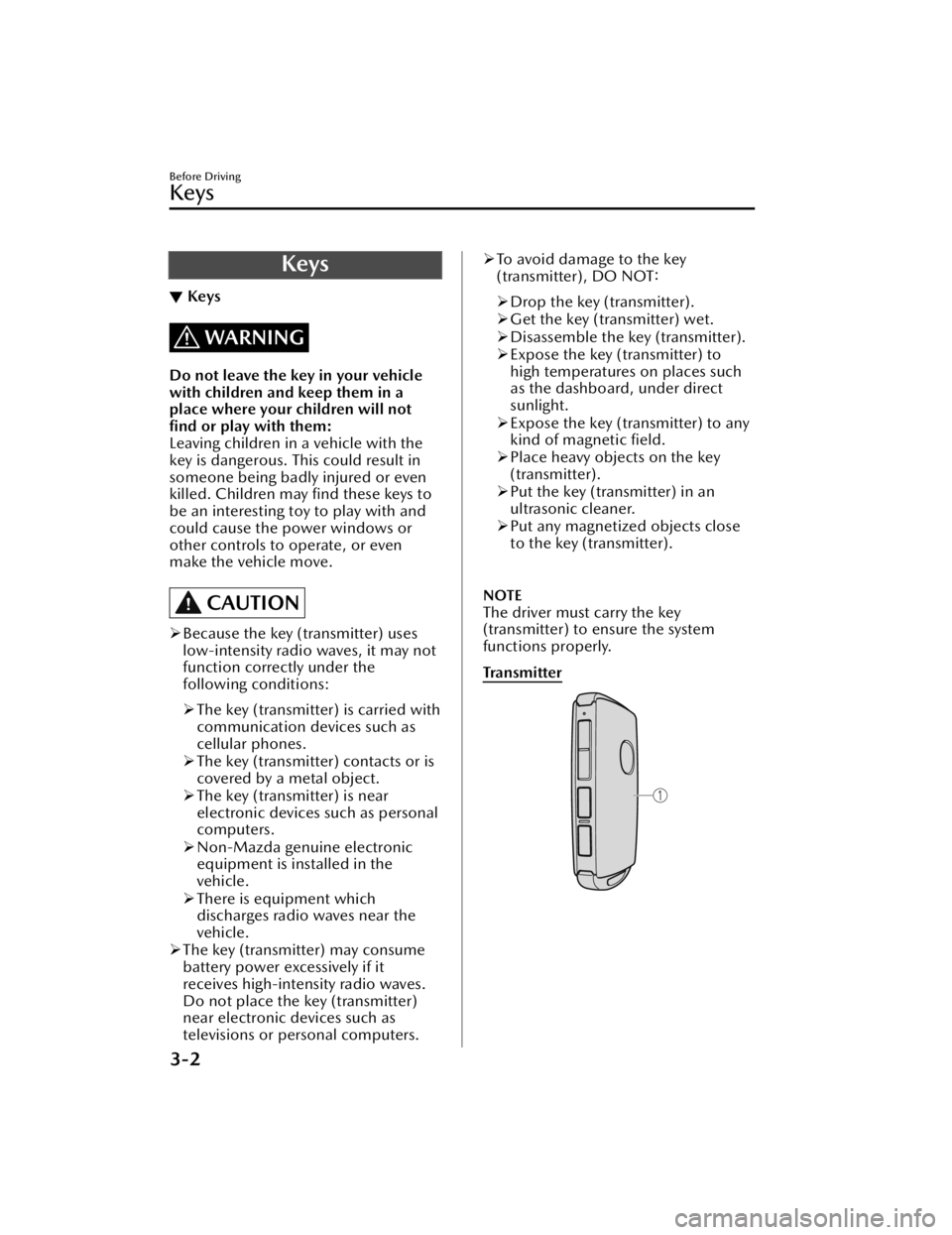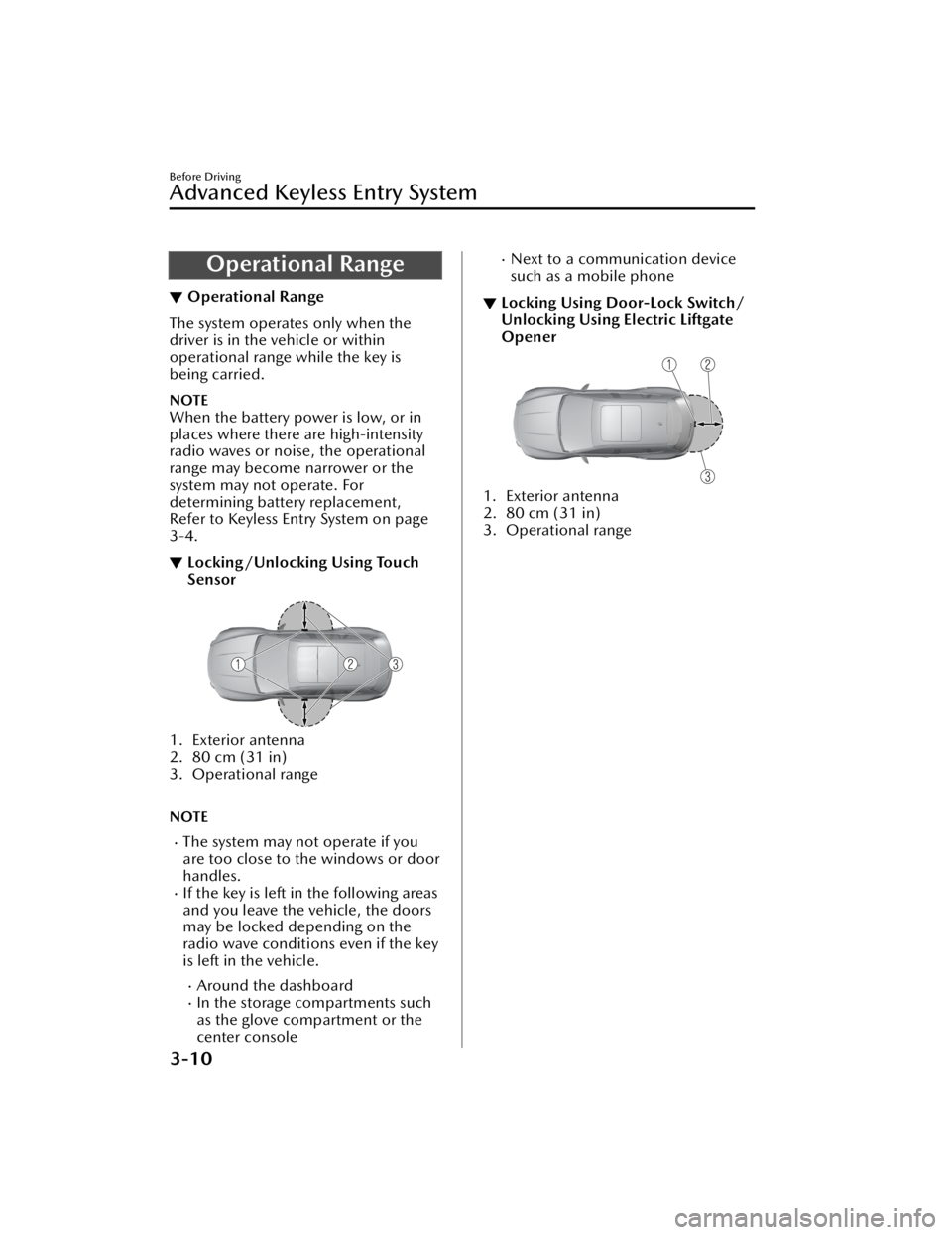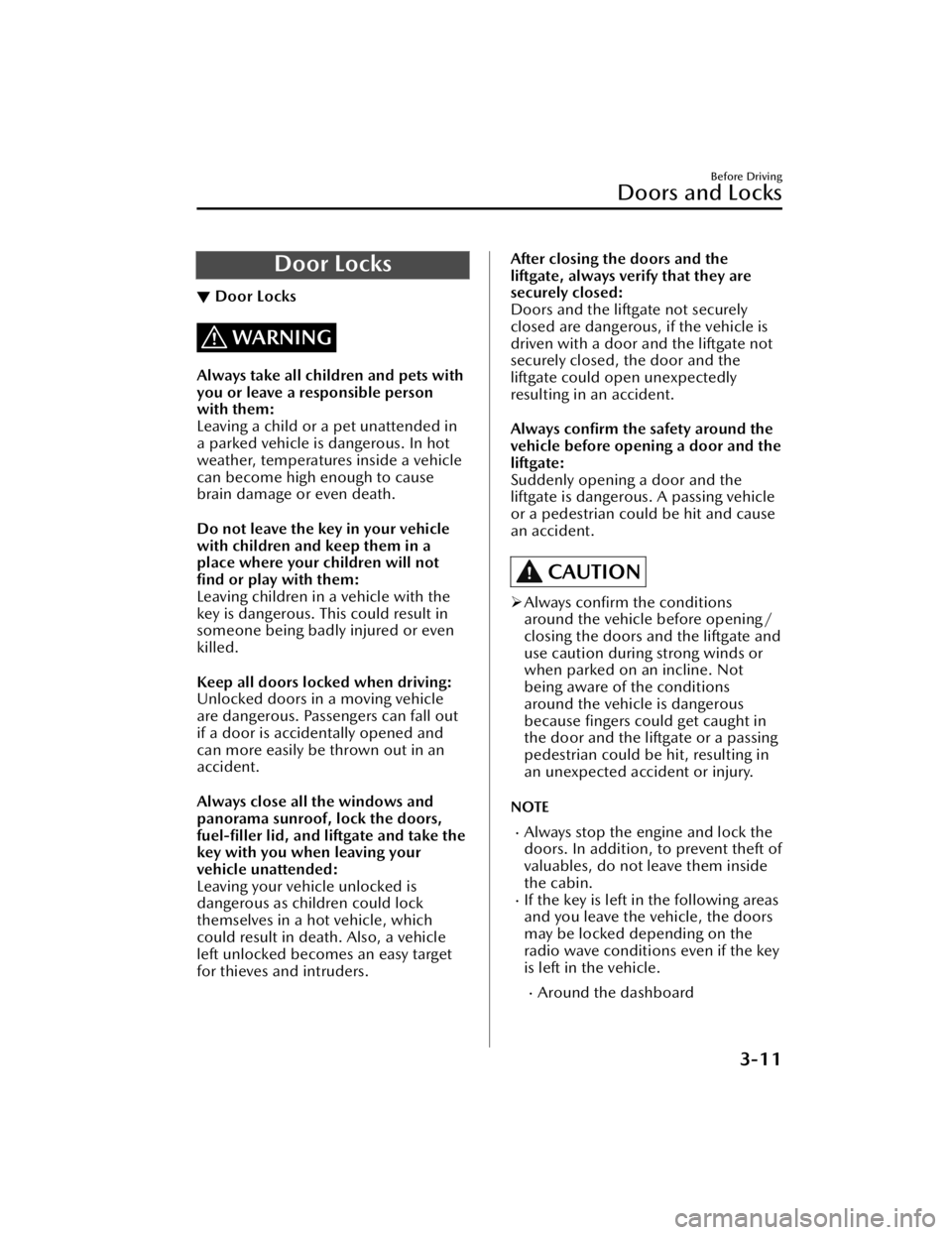dashboard MAZDA MODEL CX-50 2023 Owners Manual
[x] Cancel search | Manufacturer: MAZDA, Model Year: 2023, Model line: MODEL CX-50, Model: MAZDA MODEL CX-50 2023Pages: 583, PDF Size: 85.63 MB
Page 69 of 583

Supplemental Restraint
System (SRS) Precautions
▼ Supplemental Restraint System
(SRS) Precautions
The front and side supplemental
restraint systems (SRS) include
different
types of air bags. Please verify the
different types of air bags which are
equipped on your vehicle by locating
the “SRS AIRBAG” location indicators.
These indicators are visible in the area
where the air bags are installed.
The air bags are installed in the
following locations:
The steering wheel hub (driver air
bag)
The front passenger dashboard (front
passenger air bag)
Under the instrument panel (driver
and front passenger* knee air bags)The outboard sides of the front
seatbacks (side air bags for driver
and front passenger)
The outboard sides of the rear
seatbacks (side air bags for rear
passengers)
*
The front and rear window pillars,
and the roof edge along both sides
(curtain air bags)
Vehicles with the Driver and Front
Passenger Occupant Classification
System have a sensor which detects an
impending roll-over accident.
The air bag supplemental restraint
systems are designed to provide
supplemental protection in certain
situations so seat belts are always
important in the following ways:
Without seat belt usage, the air bags
cannot provide adequate protection
during an accident. Seat belt usage is
necessary to:
Keep the occupant from being
thrown into an inflating air bag.
Reduce the possibility of injuries
during an accident that is not
designed for air bag inflation, such as
rear impact.
Reduce the possibility of injuries in
frontal, near frontal or side collisions
or roll-over accidents that are not
severe enough to activate the air
bags.
Reduce the possibility of being
thrown from your vehicle.
Reduce the possibility of injuries to
lower body and legs during an
accident.
Hold the driver in a position which
allows better control of the vehicle.
If your vehicle is also equipped with a
driver and front passenger occupant
classification system, refer to the Front
Passenger Occupant Classification
System (page 2-67) for details.
If your vehicle is equipped with a driver
and front passenger occupant
classification system, the front
passenger air bag deactivation
indicator light illuminates for a
Essential Safety Equipment
SRS Air Bags
2-52*Some models.
CX-50_8KB8-EA-22A_Edition2_new 2022-1-6 14:55:18
Page 71 of 583

Do not sit too close to the driver and
front passenger air bags:
Sitting too close to the driver and front
passenger air bag modules or placing
hands or feet on them is extremely
dangerous. The driver and front
passenger air bags inflate with great
force and speed. Serious injuries could
occur if someone is too close. The
driver should always hold onto only the
rim of the steering wheel. The front
seat passenger should keep both feet
on the floor. Front seat occupants
should adjust their seats as far back as
possible and always sit upright against
the seatbacks with seat belts worn
properly.
Sit in the center of the seat and wear
seat belts properly:
Sitting too close to the side air bag
modules or placing hands on them, or
sleeping up against the door or
hanging out the windows is extremely
dangerous. The side and curtain air
bags inflate with great force and speed
directly expanding along the door on
the side the car is hit. Serious injury
could occur if someone is sitting too
close to the door or leaning against a
window, or if rear seat occupants grab
the sides of the front seatbacks. Give
the side and curtain air bags room to
work by sitting in the center of the seat
while the vehicle is moving with seat
belts worn properly.
Do not attach objects on or around
the area where air bags deploy:Attaching objects to the air bags or
placing something in the area where
the air bags deploy is dangerous. In an
accident, an object could interfere with
air bag inflation and injure the
occupants. Furthermore, the bag could
be damaged causing gases to release.
Always keep the deployment area of
the air bag modules free of any
obstructions.
For example, you should not do any of
the following as it may interfere with
air bag deployment.
Do not put a covering on or lean
anything against areas such as the
dashboard and lower portion of the
instrument panel that blocks the
passenger front air bag and knee air
bags.
Do not use seat covers on the front
seats and rear seats equipped with
in-seat side air bags.
Do not hang any backpacks, bags or
pouches that cover the sides of the
seats that block the side air bags.
Do not place any objects on the
assist grips. Only hang clothes
directly on the coat hooks.
Do not touch the components of the
supplemental restraint system after
the air bags have inflated:
Touching the components of the
supplemental restraint system after the
air bags have inflated is dangerous.
Immediately after inflation, they are
very hot. You could get burned.
Essential Safety Equipment
SRS Air Bags
2-54
CX-50_8KB8-EA-22A_Edition2_new 2022-1-6 14:55:18
Page 73 of 583

Do not modify the supplemental
restraint system:
Modifying the components or wiring of
the supplemental restraint system is
dangerous. You could accidentally
activate it or make it inoperable. Do
not make any modifications to the
supplemental restraint system. This
includes installing trim, badges, or
anything else over the air bag modules.
It also includes installing extra
electrical equipment on or near system
components or wiring. An Authorized
Mazda Dealer can provide the special
care needed in the removal and
installation of front seats. It is
important to protect the air bag wiring
and connections to assure that the
bags do not accidentally deploy, and
that the front passenger occupant
classification system and the seats
retain an undamaged air bag
connection.
Do not place luggage or other objects
under the front seats:
Placing luggage or other objects under
the front seats is dangerous. The
components essential to the
supplemental restraint system could be
damaged, and in the event of a side
collision, the appropriate air bags may
not deploy, which could result in death
or serious injury. To prevent damage to
the components essential to the
supplemental restraint system, do not
place luggage or other objects under
the front seats.
Do not operate a vehicle with
damaged air bag/seat belt
pretensioner system components:Expended or damaged air bag/seat
belt pretensioner system components
must be replaced after any collision
which caused them to deploy or
damage them. Only a trained
Authorized Mazda Dealer can fully
evaluate these systems to see that they
will work in any subsequent accident.
Driving with an expended or damaged
air bag or pretensioner unit will not
afford you the necessary protection in
the event of any subsequent accident
which could result in serious injury or
death.
Do not remove interior air bag parts:
Removing any components such as the
front seats, front dashboard, the
steering wheel or parts on the front
and rear window pillars and along the
roof edge, containing air bag parts or
sensors is dangerous. These parts
contain essential ai r bag components.
The air bag could accidentally activate
and cause serious injuries. Always have
an Authorized Mazda Dealer remove
these parts.
Properly dispose of the air bag
system:
Improper disposal of an air bag or a
vehicle with live air bags in it can be
extremely dangerous. Unless all safety
procedures are followed, injury could
result. Have an Authorized Mazda
Dealer safely dispose of the air bag
system or scrap an air bag equipped
vehicle.
Essential Safety Equipment
SRS Air Bags
2-56
CX-50_8KB8-EA-22A_Edition2_new 2022-1-6 14:55:18
Page 78 of 583

▼Front Passenger Air Bag
The front passenger air bag is mounted
in the front passenger dashboard.
The inflation mechanism for the front
passenger air bag is the same as the
driver's air bag.
For more details about air bag
deployment, refer to "SRS Air Bag
Deployment Criteria" (page 2-63).
(With Driver and Front Passenger
Occupant Classification System)
In addition, the front passenger air bag
is designed to only deploy in
accordance with the total seated
weight on the front passenger seat. For
details, refer to the driver and front
passenger occupant classification
system (page 2-67).
▼Driver and Front Passenger Knee
Air Bags*
The knee air bags are equipped under
the instrument panel.
If the air bag crash sensors receive a
frontal impact of greater than
moderate force, the knee air bags
deploy immediately to reduce impact
to the driver and front passenger's
legs.
For more details about air bag
deployment, refer to "SRS Air Bag
Deployment Criteria" (page 2-63).
▼Side Air Bags
There are 2 types of side air bags
including the side air bags for the
driver and front passenger and rear
passengers.
Front seat side air bags
The front seat side air bags are
mounted in the outboard sides of the
front seatbacks.
When the air bag crash sensors detect
a side impact of greater than moderate
force, the system
inflates the side air
bag only on the side in which the
vehicle was hit. The side air bag inflates
quickly to reduce injury to the driver or
front passenger's chest caused by
directly hitting interior parts such as a
door or window.
For more details about air bag
deployment, refer to "SRS Air Bag
Deployment Criteria" (page 2-63).
(With Driver and Front Passenger
Occupant Classification System)
In addition, the front passenger side air
bag is designed to only deploy in
accordance with the total seated
weight on the front passenger seat. For
details, refer to the driver and front
Essential Safety Equipment
SRS Air Bags
*Some models.2-61
CX-50_8KB8-EA-22A_Edition2_new 2022-1-6 14:55:18
Page 91 of 583

Keys
▼Keys
WARNING
Do not leave the key in your vehicle
with children and keep them in a
place where your children will not
find or play with them:
Leaving children in a vehicle with the
key is dangerous. This could result in
someone being badly injured or even
killed. Children may find these keys to
be an interesting toy to play with and
could cause the power windows or
other controls to operate, or even
make the vehicle move.
CAUTION
Because the key (transmitter) uses
low-intensity radio waves, it may not
function correctly under the
following conditions:
The key (transmitter) is carried with
communication devices such as
cellular phones.
The key (transmitter) contacts or is
covered by a metal object.
The key (transmitter) is near
electronic devices such as personal
computers.
Non-Mazda genuine electronic
equipment is installed in the
vehicle.
There is equipment which
discharges radio waves near the
vehicle.
The key (transmitter) may consume
battery power excessively if it
receives high-intensity radio waves.
Do not place the key (transmitter)
near electronic devices such as
televisions or personal computers.
To avoid damage to the key
(transmitter), DO NOT:
Drop the key (transmitter).
Get the key (transmitter) wet.
Disassemble the key (transmitter).
Expose the key (transmitter) to
high temperatures on places such
as the dashboard, under direct
sunlight.
Expose the key (transmitter) to any
kind of magnetic field.
Place heavy objects on the key
(transmitter).
Put the key (transmitter) in an
ultrasonic cleaner.
Put any magnetized objects close
to the key (transmitter).
NOTE
The driver must carry the key
(transmitter) to ensure the system
functions properly.
Tra n s m i t te r
Before Driving
Keys
3-2
CX-50_8KB8-EA-22A_Edition2_new 2022-1-6 14:55:18
Page 97 of 583

With the advanced keyless function
1. Interior antenna
2. Operational range
Without the advanced keyless
function
1. Interior antenna
2. Operational range
NOTE
The engine may not start if the key is
placed in the following areas:
Around the dashboardIn the storage compartments such as
the glove compartment or the center
console
▼Key Suspend Function
If a key is left in the vehicle, the
functions of the key left in the vehicle
are temporarily suspended to prevent
theft of the vehicle.
To restore the functions, press the
unlock button on the
functions-suspended key in the
vehicle.
Before Driving
Keys
3-8
CX-50_8KB8-EA-22A_Edition2_new
2022-1-6 14:55:18
Page 99 of 583

Operational Range
▼Operational Range
The system operates only when the
driver is in the vehicle or within
operational range while the key is
being carried.
NOTE
When the battery power is low, or in
places where there are high-intensity
radio waves or noise, the operational
range may become narrower or the
system may not operate. For
determining battery replacement,
Refer to Keyless Entry System on page
3-4.
▼Locking/Unlocking Using Touch
Sensor
1. Exterior antenna
2. 80 cm (31 in)
3. Operational range
NOTE
The system may not operate if you
are too close to the windows or door
handles.
If the key is left in the following areas
and you leave the vehicle, the doors
may be locked depending on the
radio wave conditions even if the key
is left in the vehicle.
Around the dashboardIn the storage compartments such
as the glove compartment or the
center console
Next to a communication device
such as a mobile phone
▼
Locking Using Door-Lock Switch/
Unlocking Using Electric Liftgate
Opener
1. Exterior antenna
2. 80 cm (31 in)
3. Operational range
Before Driving
Advanced Keyless Entry System
3-10
CX-50_8KB8-EA-22A_Edition2_new
2022-1-6 14:55:18
Page 100 of 583

Door Locks
▼Door Locks
WARNING
Always take all children and pets with
you or leave a responsible person
with them:
Leaving a child or a pet unattended in
a parked vehicle is dangerous. In hot
weather, temperatures inside a vehicle
can become high enough to cause
brain damage or even death.
Do not leave the key in your vehicle
with children and keep them in a
place where your children will not
find or play with them:
Leaving children in a vehicle with the
key is dangerous. This could result in
someone being badly injured or even
killed.
Keep all doors locked when driving:
Unlocked doors in a moving vehicle
are dangerous. Passengers can fall out
if a door is accidentally opened and
can more easily be thrown out in an
accident.
Always close all the windows and
panorama sunroof, lock the doors,
fuel-filler lid, and liftgate and take the
key with you when leaving your
vehicle unattended:
Leaving your vehicle unlocked is
dangerous as children could lock
themselves in a hot vehicle, which
could result in death. Also, a vehicle
left unlocked becomes an easy target
for thieves and intruders.
After closing the doors and the
liftgate, always verify that they are
securely closed:
Doors and the liftgate not securely
closed are dangerous, if the vehicle is
driven with a door and the liftgate not
securely closed, the door and the
liftgate could open unexpectedly
resulting in an accident.
Always confirm the safety around the
vehicle before opening a door and the
liftgate:
Suddenly opening a door and the
liftgate is dangerous. A passing vehicle
or a pedestrian could be hit and cause
an accident.
CAUTION
Always confirm the conditions
around the vehicle before opening/
closing the doors and the liftgate and
use caution during strong winds or
when parked on an incline. Not
being aware of the conditions
around the vehicle is dangerous
because fingers could get caught in
the door and the liftgate or a passing
pedestrian could be hit, resulting in
an unexpected accident or injury.
NOTE
Always stop the engine and lock the
doors. In addition, to prevent theft of
valuables, do not leave them inside
the cabin.
If the key is left in the following areas
and you leave the vehicle, the doors
may be locked depending on the
radio wave conditions even if the key
is left in the vehicle.
Around the dashboard
Before Driving
Doors and Locks
3-11
CX-50_8KB8-EA-22A_Edition2_new 2022-1-6 14:55:18
Page 131 of 583

Modification and
Add-On Equipment
▼ Modification
and Add-On
Equipment
Mazda cannot guarantee the
immobilizer and the theft-deterrent
system's operation if the system has
been modified or if any add-on
equipment has been installed.
CAUTION
To avoid damage to the vehicle, do not
modify the system or install any add-on
equipment to the immobilizer and the
theft-deterrent systems or the vehicle.
Immobilizer System
▼ Immobilizer System
The immobilizer system allows the
engine to start only with a key the
system recognizes.
If someone attempts to start the
engine with an unrecognized key, the
engine will not start, thereby helping to
prevent vehicle theft.
If you have a problem with the
immobilizer system or the key, consult
an Authorized Mazda Dealer.
CAUTION
Radio equipment like this is
governed by laws in the United
States.
Changes or modifications not
expressly approved by the party
responsible for compliance could
void the user's authority to operate
the equipment.
To avoid damage to the key, do not:
Drop the key.
Get the key wet.
Expose the key to any kind of
magnetic field.
Expose the key to high
temperatures on places such as the
dashboard, under direct sunlight.
If the engine does not start with the
correct key, and the security indicator
light keeps illuminating or flashing ,
the system may have a malfunction.
Consult an Authorized Mazda
Dealer.
Before Driving
Security System
3-42
CX-50_8KB8-EA-22A_Edition2_new 2022-1-6 14:55:18
Page 132 of 583

NOTE
The keys carry a unique electronic
code. For this reason, and to assure
your safety, obtaining a replacement
key requires security validation, this
will add some delays in supplying a
replacement key. They are only
available through an Authorized
Mazda Dealer.
Always keep a spare key in case one
is lost. If a key is lost, consult an
Authorized Mazda Dealer as soon as
possible.
If you lose a key, an Authorized
Mazda Dealer will reset the
electronic codes of your remaining
keys and immobilizer system. Bring
all the remaining keys to an
Authorized Mazda Dealer to reset.
Starting the vehicle with a key that
has not been reset is not possible.
▼Operation
NOTE
The engine may not start and security
indicator light may illuminate or flash
if the key is placed in an area where
it is difficult for the system to detect
the signal, such as on the dashboard
or in the glove compartment. Move
the key to a location within the signal
range, switch the ignition
off, and
then restart the engine.
Signals from a TV or radio station, or
from a transceiver or mobile
telephone could interfere with your
immobilizer system. If you are using
the proper key and the engine fails to
start, check the security indicator
light.
Arming
The system is armed when the ignition
is switched from ON to off.
The security indicator light in the
instrument cluster flashes every 2
seconds until the system is disarmed.
Disarming
The system is disarmed when the
ignition is switched ON with the
correct programmed key. The security
indicator light illu minates for about 3
seconds and then turns off.
If the engine does not start with the
correct key, and the security indicator
light remains illuminated or flashing,
try the following:
Make sure the key is within the
operational range for signal
transmission. Switch the ignition off,
and then restart the engine. If the
engine does not start after 3 or more
tries, contact an Authorized Mazda
Dealer.
Before Driving
Security System
3-43
CX-50_8KB8-EA-22A_Edition2_new 2022-1-6 14:55:18